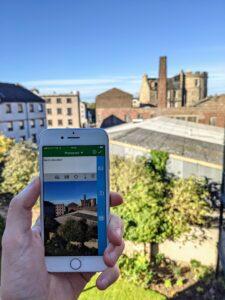At our recent Trident Day, we got to meet all of our new joiners in person for the first time. They let us know that one of the reasons they wanted to join Team Trident, was due to the range and variety of projects we work on and services we provide.
This got us thinking, Building Surveying is so vast in scale and scope today, but where did it all begin?
It may surprise you to learn that it is only within the past 50 years, that building surveying emerged as its own profession. Despite this, building surveyors have existed for much longer, and the traces of the profession can be seen as early as ancient Egypt. Below we explore, the history of building surveying.
 THE FOREFATHER’S OF BUILDING SURVEYING
THE FOREFATHER’S OF BUILDING SURVEYING
While ‘building surveying’ is a fairly recent profession, there are several roles in history that can be seen to be the beginnings of modern building surveyors.
In ancient times, evidence of surveying work, especially land surveying exists. For example, the Egyptians used rope, with knots at various intervals of significance, to measure out land for taxation, and the Greeks invented the diopter.
Argued to be the first piece of surveying equipment, the diopter was used to measure terrestrial and astronomical elements on a property. This eventually led to the development of the first set of standards and guidelines for land surveying methods. It is likely that these skills were then brought over to Britain by the Romans; AD 43–C. 410.
In 13th century England, as monks and priests were more literate than the builders of the age, they took responsibility, and supervised the construction of religious property. They became known as ‘Clerks of work’, another early link to the profession of building surveying.
However, it is the Great Fire of London in 1666, that can be said to be the real birth of building surveying as we know it today. The devastating fire that swept through London, destroyed 13,200 house, 87 Parish churches, the royal exchange, guildhall and St Paul’s Cathedral.
As a result, the Act of the Rebuilding of the City of London, established that houses had to be rebuilt using fire resistant materials, and that the width of the streets must be adequate to stop the rapid spread of flames. Most importantly, the Act called for “One of more discreet and intelligent persons knowledge in the art of building to see the said rules well and truly observed” – The beginnings of the modern building surveyor.
THE SURVEYORS CLUB, INSTITUE OT SURVEYORS AND RICS
Today, most surveyors are chartered and are RICS members. As a governing body, the origin of RICS can be traced back to the formation of the Surveyors Club in 1792, due to changes caused by the Industrial Revolution.
The Industrial Revolution, though contested among historians, is said to be the period between 1760 and 1830. In this time there was an expansion of steam and iron production, and a move from an agrarian economy to one dominated by industry and machine manufacturing. With this rapid change a progression in infrastructure, housing and transport was needed.
As the property market began to grow, the surveyors club, which later became a legal body in 1868 known as The Institute of Surveyors, was set up to represent the expanding group of property professionals. – This is the start of RICS as we know it today.
In 1868, John Clutton was elected the first president of the Institute of Surveyors and offices were leased at 12 Great George Street – The current HQ of RICS. Not long after this in 1881, the Royal Charter was given.
BUILDING SURVEYING EMERGED
The rise in domestic refurbishment work due to grants by local authorities and the first national building regulations in 1965, required for the first time, building control surveyors across the country to inspect both building plans and works on site for compliance within regulations. It was these changes that really developed the profession and their emergence as a separate profession in the 1970’s.

Over the course of the 1970s and 80s colleges in Scotland started to train building surveyors. Chartered Building Surveyors then emerged as a more uniform profession across England and Scotland and over time, quantity surveyors tended to retreat from building surveying.
It’s impressive to reflect on how much building surveying has grown from it’s ancient beginnings and then even more so in the past 50 years. We look forward to continuing to grow and innovate along with the needs of the market. To see our full list of services, click here.
More sources:
Smith, M. and Gorse, C.A. (2021) Building surveyor’s Pocket Book. Abingdon, Oxon: Routledge.
Wilkinson, S.J. and Kibblewhite, T. (2004) Building Surveying: A UK Phenomenon or a Profession with Genuine Global Appeal. Online.


